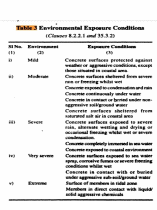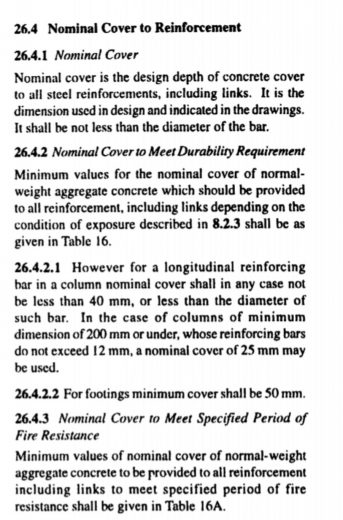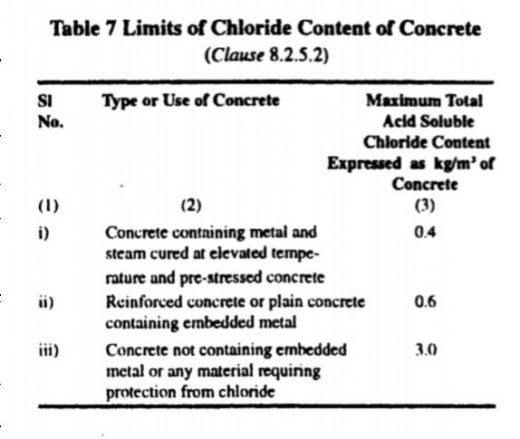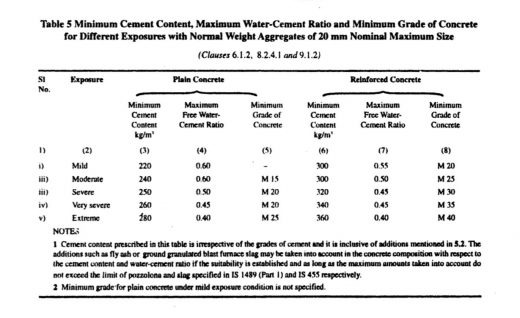Introduction
Durability of concrete implies that a concrete can withstand any harsh environment without undergoing any change in structure. IS 456-2000 has specified norms that address the issues of the durability of concrete. Usually, a concrete can stand severe environment but when certain conditions like sea water exposure or sulphate and chloride attack is encountered with concrete then it becomes difficult for concrete to withstand such exposures. In such cases, along with concrete certain additives like accelerators or admixtures are required to add with concrete to make it durable. All these will be discussed in details here.
Parameters That Affect Durability
1.Sea water exposure – A structure when it becomes exposed to sea water or spray of sea water then it becomes vulnerable in the tidal or splash zone where there are repeated cycles of wetting and drying and for freezing conditions as well as for thawing conditions. Sulphates and chlorides present in sea water require the use of permeability concrete to minimize the corrosion of steel a sulphate attack. A cement resistant to sulphate exposure is helpful in such conditions. To counteract such attacks, proper concrete cover reinforcing steel must be provided and the water cementitious ratio should not exceed 0.40.
2. Resistance to chloride and steel corrosion – Chloride present in plain concrete that does contain steel is generally not a durability concern. Concrete protects the embedded steel from corrosion through its highly alkaline nature. The high pH environment in concrete (usually high pH is referred to greater than 12.5) causes a passive and non corroding protective oxide film to form on steel. However, the presence of chloride ions can destroy or penetrate the film. Once the chloride corrosion threshold, reached, an electric cell is formed along the steel or between steel bars and electrochemical process begins.
For severe environments such as bridge decks, it can be increase by using a low water-cementitious ratio (about 0.4) at least seven days of moist curing, supplementary cementitious material such as silica fume to reduce permeability. Increasing the concrete cover helps to slow down the migration of chlorides in voids of concrete.
3. Resistance to Alkali-Silica Reaction (ASR)- ASR is an expansive reaction between reactive forms of silica in aggregates and potassium and sodium alkalis, mostly from cement, but also from aggregates, pozzolanas, admixtures and mixing water. The reactivity is potentially harmful only when it produces significant expansion. Indications of the presence of alkali-aggregate reactivity maybe a network of cracks, closed or spalling joints or movement of portions of structure. ASR can be controlled through proper selection of aggregates and the use of supplementary cementitious material (such as fly ash or slag cement) or blended cements proven by testing to control the reaction.
4. Abrasion resistance – Corrosion is resistant to abrasive effects of ordinary weather. Examples of severe abrasion and erosion are particles in rapidly moving water like rivers in case of bridges, floating ice or areas where steel studs are allowed on tires. Abrasion resistance is directly related to the strength of he concrete.
Factors Influencing Durability As Per Is 456-2000
As per IS 456-2000, the factors are –
a.The environment – The general environment to which the concrete will be exposed during its working life is classified into five levels of severity which are mild, moderate, severe, very severe and extreme which is described in Table 3 of IS 456-2000.

When freezing and thawing actions under wet conditions exist, enhanced durability can be obtained by the use of suitable air entraining admixtures.
When in very high sulphate concentrations in class 5 conditions exist, some form of lining such as polyethylene or poly chloropropene sheet; or surface coating based on asphalt, chlorinated rubber, etc. materials should be used to prevent access by the sulphate solution
b. Cover to embedded steel – The protection of the steel in concrete against corrosion depends upon an adequate thickness of good quality concrete. The nominal cover to reinforcement shall be provided as per Cl 26.4 of IS 456-2000.

c. Quality and type of constituent materials– For concrete to be durable, careful selection of the mix and materials is necessary, so that deleterious constituents do not exceed the necessary limits. Whenever the chloride is present in the concrete, an increased risk of corrosion embedded metal. Hence, the amount of chloride content in the concrete at the time of placing shall be given as Table 7 of the code. In case of sulphates, excessive amount can cause expansion and disruption of concrete. To prevent this, the total-water-soluble content should not exceed by 4% by mass of cement in the mix.

d. Water cement ratio and cement content – Cement content (minimum) and maximum free water cement ratio should be given by following table 5 of the code. Cement content not including fly ash and ground granulated blast furnace slag in excess of 450 kg/m3 should not be used unless special consideration has been given in design.

e. Workmanship to obtain full compaction and efficient curing – Adequate compaction without segregation should be ensured by providing suitable workability and by employing appropriate placing and compaction equipment and procedures. It is also essential to use proper and adequate curing techniques to reduce the permeability of concrete.
f. Shape and size of member –The shape or design details of exposed structures should be such as to promote good drainage of water and to avoid standing pools and rundown of water. Care should be taken to minimize cracks they may collect or transmit water.
Conclusion
Although many such suggestions are provided by Indian Standard, there are many other suggestions which are given differently in other country’s codes. The situations may differ country wise but those solutions may also be used which may give surprising results. Like for instance ACI code can also be used to produce concrete and it may prove to be economic as coarse aggregate quantity is higher in IS code compared to ACI. Likewise many other codes can also be used to produce more durable concrete.
If you have a query, you can ask a question here.


